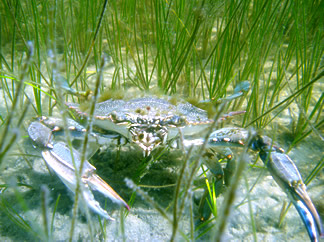A region’s wildlife can be defined as the native fauna, or animals, that are undomesticated and living in the wild. Wildlife is greatly enjoyed by outdoor enthusiasts, birdwatchers, and hunters alike, although for very different reasons. Whether protection of wildlife is of interest because it is beautiful, edible, or intrinsically valuable, wildlife needs certain habitat types in order to survive.
When any endangered or threatened species in the U.S. is listed under the Endangered Species Act, its essential habitat (habitat essential to its survival) is designated as critical habitat (USFWS 2013c)*. Estuaries provide critical habitat for many wildlife species and their prey and decreased freshwater inflows can adversely affect these habitats. Much estuarine- specific vegetation such as seagrass is adapted to survive on substrate that is at least partially inundated the majority of the time. Lack of freshwater inflows and drought conditions reduce estuarine vegetative cover that can provide breeding grounds, shelter, and prey for species causing stressors to wildlife populations (Montagna et al. 2013b).
In Texas, wildlife includes the protected native wild mammals, birds, reptiles, amphibians, and freshwater organisms. Texas’ dominant habitat types within estuaries include unconsolidated sand or mud, seagrass beds, saltmarshes, oyster reefs, and mangroves. The location and range of estuarine habitat types can be correlated with the average annual precipitation gradient that occurs along the Texas coast. The northeastern Texas coastal area is classified as humid while the southwesterly Texas coastal area is considered subtropical and semiarid. Some examples of important estuarine wildlife species in Texas include whooping cranes, black drum, red drum, shrimp, oysters, crabs, and many others. Critical wildlife habitat is valued because it provides essential components necessary for many wildlife species.

*Critical habitat for threatened and endangered species can be found using a GIS based tool provided by the US Fish and Wildlife Service
Dynamic commercial and recreational fisheries are inappreciably linked to healthy marine habitats (NOAA 2013). Essential fish habitats are the healthy environments fish and other aquatic and semi-aquatic organisms need to survive, feed, reproduce, and grow to maturity. Estuaries provide essential habitat conditions for various shellfish species and nursery habitat for fish.